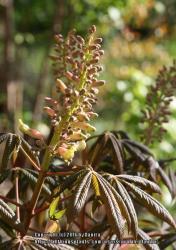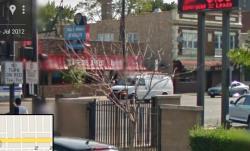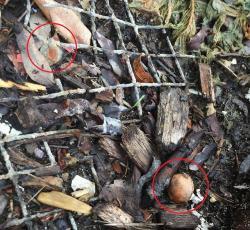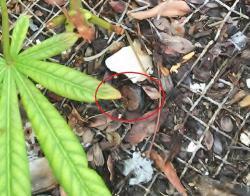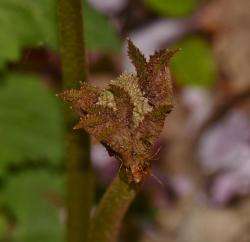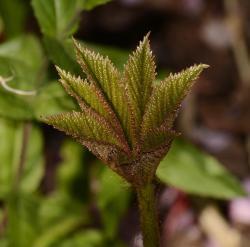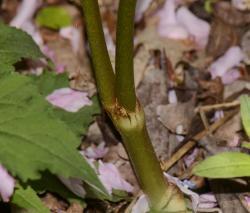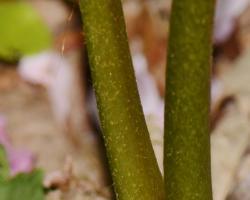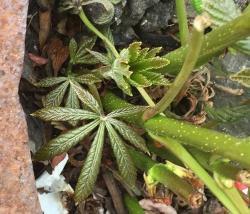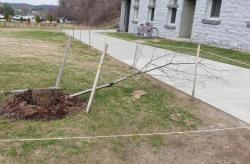Time will tell! Both possibilities seem odd and difficult to explain. If the stems harden later in the year we can rule out Rodgersia, assuming they don't all get cut off.
Things to consider for Aesculus:
1) 5 to 7 leaves
2) Dead tree not likely to have been Aesculus.
3) Wire surrounding stump where plants are growing so a squirrel wouldn't be able to bury seeds.
4) There is a 'conker' on the surface.
5) Wire could have been removed to bury conkers and replaced but the growth is too robust for first year seedlings.
6) No obvious signs of plants present in November 2015 or earlier.
7) There may be one thinner old stem showing behind current stems, a second one I ringed I think is a current stem cut off and browning as
an earlier pic shows a green cut off stem.
8) There's Elm seeds on the ground.
9) A further light brown oval shaped possible seed is present.
10) If growing from conkers, after several days, in fact two weeks and 3 days, the leaves have still not opened out flat like an Aesculus would do. The leaves on my tree as still drooping a little although nearly straightened out, and are not curled under at the edges.
11) The stems look fleshy, but have developed white 'spots' after initially having none. New stems on Horse Chestnut don't look so fleshy.
12) What are the chances the dead tree was a hybrid Aesculus, and the growths are coming from the cut off trunk collar?
The leaves I thought resembled Elm I have ringed, they are dark and the pic is blurred but check the shape out with the pic of Accolade Elm twig & leaves on the following link:
https://www.google.co.uk/searc...
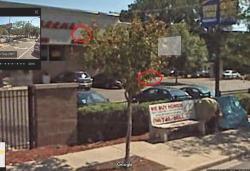
Things to consider for Rodgersia:
1) Quick growing
2) Leaves match Rodgersia aesculifolia but could easily match Aesculus, if one with 7 leaves could be found which behaves like this.
3) The chances of a Rodgersia growing there seems low, and if someone had planted some there then they are well advanced considering
there was nothing visible in the google steet images. The only way I can see such advanced plants could be Rodgersia is if more than one was planted this spring, with varying sizes of plants. Why would anyone do that? To cover the stump? Someone had plants spare so thought it was a good way to use them?

Could the plants have been growing other years but after google street took images, and died back before later images were taken?
4) Rodgersia stems are fleshy, the thickest of mine is around half an inch and only just emerged.
5) Do Rodgersia stems have white 'spots'? They might have!
I went back through the pics, I noticed something which seems odd for Aesculus on one of the younger stems. There appears to be a 'collar' at ground level which the stem appears to be growing out of. My biggest Rodgersia stem has burst from a similar collar.
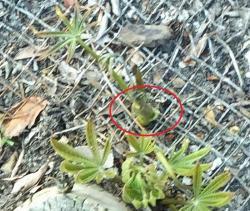
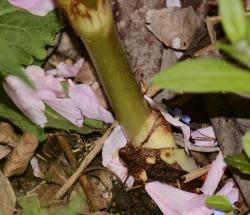
What is that other seed, it looks much like Aesculus pavia. Could it be a hybrid of A. pavia which is quick growing?
https://www.google.co.uk/searc...
https://www.google.co.uk/searc...
http://thequeenofseaford.blogs...
https://www.google.co.uk/searc...
Danita said:Has anyone compared it to the hybrid Aesculus x carnea cultivars?
They are A. hippocastanum x A. pavia crosses. They can have 5-7 leaflets. The are also used as street trees.
I have no experience with Aesculus x carnea but I have Aesculus pavia. In Aesculus pavia, the new leaves emerge in an upright position right before drooping. They also keep that "droopy and curled around the edges" look for a while. A. pavia has 5 leaflets though, so that's why I wondered about the hybrids which might combine some of the characteristics of both parents.
Here is my Aesculus pavia still sporting its "droopy and curled" look.
